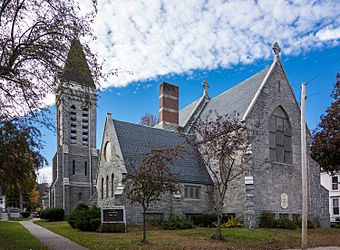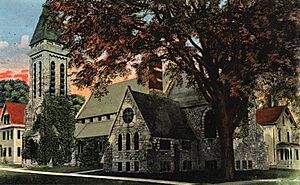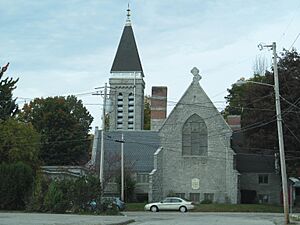St. Mark's Episcopal Church (Augusta, Maine) facts for kids
Quick facts for kids |
|
|
St. Mark's Episcopal Church
|
|

The church in 2013
|
|
| Location | 9 Summer St., Augusta, Maine |
|---|---|
| Area | 0.5 acres (0.20 ha) |
| Built | 1886 |
| Architect | Richard M. Upjohn |
| Architectural style | Gothic |
| NRHP reference No. | 84001379 |
| Added to NRHP | July 19, 1984 |
St. Mark's Episcopal Church was a beautiful old church building in Augusta, Maine. It was built in 1886 and looked like a castle, in a style called Gothic Revival. A famous architect named Richard M. Upjohn designed it. The church building was so special that it was added to the National Register of Historic Places in 1984. The church group, called a congregation, started in 1840. They used this building until 2015.
Contents
History of St. Mark's Church
The St. Mark's church group began in 1840. Their first church was a small wooden building. It was located near where the Lithgow Library is today. The church building you see in pictures was built later, in 1886.
Building the Church in 1886
The new stone church was designed by Richard M. Upjohn. He was a well-known architect. Inside the new church, there was a special window. This window honored Saint Mark. It came from the older wooden church.
Community Help and Moving Out
The church was a busy place for the community. It helped run several important programs. These included Addie's Attic Clothing Bank. There was also the Everyday Basics Essentials Pantry. The Augusta Area Food Bank also operated there. All these programs were in the Parish Hall next to the church. The Parish Hall was built in 1959.
In 2015, the church group moved. They started worshiping at Prince of Peace Lutheran Church. This church is now called Emmanuel Lutheran Episcopal Church. The old St. Mark's church building was put up for sale in 2016.
Activities at St. Mark's Church
Besides church services, St. Mark's Church was also a place for music. Many musical performances happened there. A very popular event was an organ concert. This concert was held every spring. It had been happening since 1997.
Marilyn Tedesco Memorial Concert
In 2010, the yearly organ concert got a new name. It was called the Annual Marilyn Tedesco Memorial Concert. This was to honor Marilyn Tedesco. She was the music director and organist at St. Mark's for many years.
Architecture of the Church Building
The church building is made of granite stone. It has a main section with a pointed roof. This roof runs from east to west. There are also two parts that stick out on the south side. These parts also have pointed roofs.
Special Features of the Church
One of the parts sticking out has a tall, square tower. This tower has strong corners and a bell room. It also has a pyramid-shaped roof with a cross on top. The windows are shaped like tall, narrow arches. This is a common style in Gothic buildings. Some windows are rectangular. All the windows have decorative stone patterns.
Inside the Church
Inside the church, you can see marble columns. There is also beautiful, detailed woodwork. The ceiling above the altar area has original stencil designs. These designs are very old and special.
See also





